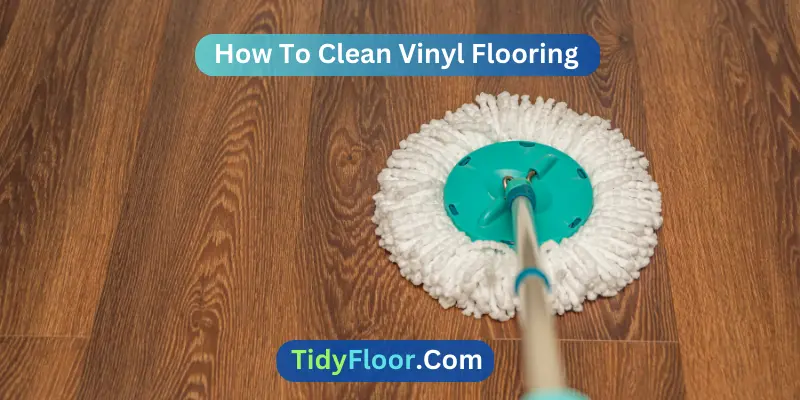Vinyl flooring has gained immense popularity for its durability, versatility, and easy maintenance. Whether you have vinyl plank or sheet flooring, keeping it clean enhances its appearance but also prolongs its lifespan. Regular vinyl floor cleaning not only removes dirt and stains but also maintains the original luster of your vinyl flooring.
To clean vinyl flooring, start by sweeping or vacuuming to remove loose dirt. Mix a solution of water and mild dish soap. Use a damp mop to scrub the floor gently. For stains, use a baking soda paste and gentle scrubbing. Rinse with clean water and dry with a soft cloth.
In this guide, we’ll walk you through the process of how to clean vinyl flooring and keep it looking its best. So if you are skeptical about the method, keep reading the guide below.
- Bucket
- Warm water
- Soft cloths.
- Broom or vacuum cleaner
- Mild pH-balanced vinyl floor cleaner
- Mop (preferably microfiber)
Time: 30 Minutes To a 1 Hours
Cost: Dollars 15 To 30
How To Clean Vinyl Flooring: 8 Step-by-Step Process
To clean vinyl floors, you need to follow the right process. As vinyl planks and To clean vinyl plank flooring, you need to have certain materials and ingredients. Here is a checklist that you can follow.
Step 1: Clear the Area
Clear the area of any furniture, rugs, or obstacles that could hinder your cleaning process. This ensures that you have a clear space to work on and prevents accidentally spreading dirt or cleaning solutions.
Step 2: Sweep or Vacuum
Begin by sweeping or vacuuming the vinyl flooring to remove loose dirt, dust, and debris. This prevents scratching the surface during the cleaning process. Use a soft-bristle broom or a vacuum cleaner with a soft brush attachment to avoid any potential damage.
Step 3: Prepare the Cleaning Solution
In a bucket, mix a mild pH-balanced vinyl floor cleaner with warm water according to the manufacturer’s instructions. Avoid using harsh chemicals, abrasive cleaners, or excessive water, as these can damage the vinyl flooring.
Step 4: Mop the Floor
Dip the mop into the prepared cleaning solution and wring it out thoroughly. The mop should be damp but not dripping. Begin mopping the vinyl flooring, working in small sections. Make sure to mop in the direction of the vinyl planks or tiles. This prevents water from seeping into the seams.
Step 5: Address Stubborn Stains
For stubborn stains, avoid using abrasive scrubbers or harsh chemicals. Instead, dampen a soft cloth with the cleaning solution and gently rub the stained area. If the stain persists, consider using a specialized vinyl floor stain remover recommended by the manufacturer.
Step 6: Rinse
After mopping, empty the bucket and refill it with clean, warm water. Use a clean mop or cloth dampened with plain water to rinse the floor, removing any residual cleaning solution. Again, make sure the mop or cloth is not overly wet.
Step 7: Dry the Floor
Dry the vinyl flooring thoroughly with a clean, dry microfiber mop or cloth. Excess moisture can damage the flooring over time, so ensure it’s completely dry before moving furniture back or walking on it.
Step 8: Routine Maintenance
To maintain the cleanliness of your vinyl flooring, establish a regular cleaning routine. Sweep or vacuum daily to prevent dirt buildup, and perform a damp mopping weekly or as needed. Place doormats at entrances to trap dirt and prevent it from being tracked onto the vinyl floor.
6 Tips About How to Clean Vinyl Floors with White Vinegar:
Vinyl floors are known for their resilience and low maintenance, and one effective and natural way to keep them clean is by using white vinegar. White vinegar is a versatile household cleaner that can effectively remove dirt, grime, and even some stains from vinyl flooring. Here are some useful tips on how to clean vinyl floors with white vinegar:
1. Dilution is Key:
White vinegar is potent, so dilute it with water before use. Mix equal parts of white vinegar and water in a bucket. This ensures that the vinegar’s acidity won’t harm the vinyl’s finish.
2. Gentle Cleaning:
Soak a soft mop or cloth in the diluted vinegar solution. Wring it out thoroughly so it’s damp but not dripping. Avoid excess moisture on vinyl floors.
3. Test in a Small Area:
Before cleaning the entire floor, test the vinegar solution in a small, inconspicuous area to ensure it doesn’t cause any adverse reactions, such as discoloration or damage.
4. Avoid Excess Water:
While vinegar is an effective cleaner, excess moisture can still damage vinyl floors. After mopping with the vinegar solution, follow up with a clean, damp mop to rinse away any residue.
5. Proper Ventilation:
Working in a well-ventilated area is crucial when using vinegar due to its strong odor. Open windows and doors to prevent the smell from lingering.
6. Follow Manufacturer’s Guidelines:
Always refer to the manufacturer’s cleaning recommendations for your specific vinyl flooring. Some manufacturers may advise against using vinegar or have specific guidelines to follow.
6 Mistakes to Avoid When Cleaning Vinyl Floors with Vinegar and Baking Soda:
Cleaning vinyl floors with a combination of vinegar and baking soda can be an effective and natural solution. However, there are certain mistakes to steer clear of to ensure that your vinyl floors remain in top-notch condition. Here’s a detailed look at the common pitfalls to avoid when using vinegar and baking soda to clean vinyl floors:
1. Overuse of Baking Soda:
While baking soda is a gentle abrasive that can help scrub away dirt, using it excessively or without proper dilution can lead to scratches on the vinyl surface. Always mix baking soda with water to create a paste and apply it sparingly.
2. Skipping the Dilution Step:
Both vinegar and baking soda need to be diluted before using them on vinyl floors. Applying undiluted vinegar or using concentrated baking soda can damage the flooring’s finish and create a hazy appearance.
3. Mixing Vinegar and Baking Soda Together:
Although these two ingredients are often used in household cleaning, combining them results in a chemical reaction that neutralizes their cleaning properties. Use them separately for the best results.
4. Using Too Much Liquid:
Excessive moisture, whether from the vinegar and baking soda solution or water used for rinsing, can seep into seams and edges, causing them to lift or warp over time. Wring out mops and clothes thoroughly before using them.
5. Using Harsh Scrubbing Pads:
While baking soda is a gentle abrasive, combining it with aggressive scrubbing pads can cause scratches. Stick to soft cloths or gentle mops to avoid damaging the vinyl surface.
6. Not Testing in a Small Area:
Before applying the vinegar and baking soda solution to the entire floor, test it in an inconspicuous spot. This helps you assess any potential negative reactions, such as discoloration or dullness.
FAQs:
Can I Use Any Cleaning Solution On My Vinyl Flooring?
It’s recommended to use a mild pH-balanced vinyl floor cleaner to avoid damage. Harsh chemicals can strip away the protective layer and cause discoloration.
How Often Should I Mop My Vinyl Flooring?
Aim for weekly mopping or as needed. High-traffic areas might require more frequent cleaning, while less-used spaces can be cleaned less often.
Can I Use A Steam Mop On Vinyl Flooring?
It’s best to avoid steam mops as excessive heat and moisture can damage the vinyl’s adhesive and cause warping. Stick to traditional damp mopping.
What If My Vinyl Flooring Has Stubborn Stains?
Gently use a cloth with the cleaning solution to address stains. If needed, consider a specialized vinyl floor stain remover. Avoid abrasive scrubbing.
Can I Use A Vacuum With A Beater Bar On Vinyl Flooring?
Opt for a vacuum with a soft brush attachment or use a soft-bristle broom. Beater bars can scratch the vinyl surface.
How Do I Prevent Water Damage While Cleaning Vinyl Floor?
Wring out the mop thoroughly to avoid excessive water on the floor. Always mop in the direction of the planks to prevent water from seeping into the seams.
Is It Necessary To Rinse The Floor After Mopping?
Yes, rinsing with clean water is essential to remove any residual cleaning solution, which can leave a dull film if not rinsed properly.
Can I Use Vinegar To Clean Vinyl Flooring?
It’s not recommended to use vinegar as it can dull the vinyl’s finish over time. Stick to a pH-balanced vinyl floor cleaner.
Can Rugs Or Furniture Discolor Vinyl Flooring?
Over time, prolonged exposure to sunlight can cause fading. To prevent this, rotate rugs and furniture regularly or use window treatments to block direct sunlight.
How Do I Maintain The Shine Of My Vinyl Flooring?
Regular cleaning and routine maintenance will maintain the shine. Avoid using wax-based products as they can leave a buildup that dulls the surface.
Conclusion
Vinyl flooring offers a beautiful combination of style and easy maintenance. By following this step-by-step guide on how to clean vinyl flooring, you can ensure that your vinyl flooring remains clean, shiny, and in great condition.
Regular cleaning and proper care will not only keep your space looking appealing but also extend the life of your vinyl flooring, making it a wise investment for years to come.


